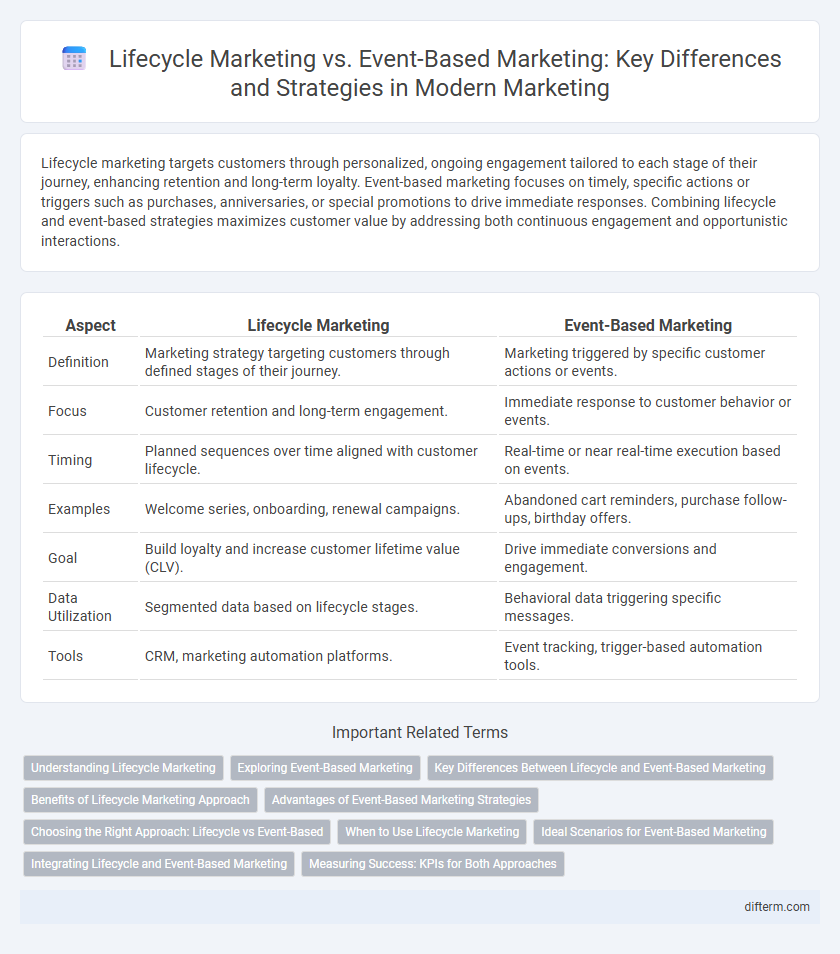Lifecycle marketing targets customers through personalized, ongoing engagement tailored to each stage of their journey, enhancing retention and long-term loyalty. Event-based marketing focuses on timely, specific actions or triggers such as purchases, anniversaries, or special promotions to drive immediate responses. Combining lifecycle and event-based strategies maximizes customer value by addressing both continuous engagement and opportunistic interactions.
Table of Comparison
| Aspect | Lifecycle Marketing | Event-Based Marketing |
|---|---|---|
| Definition | Marketing strategy targeting customers through defined stages of their journey. | Marketing triggered by specific customer actions or events. |
| Focus | Customer retention and long-term engagement. | Immediate response to customer behavior or events. |
| Timing | Planned sequences over time aligned with customer lifecycle. | Real-time or near real-time execution based on events. |
| Examples | Welcome series, onboarding, renewal campaigns. | Abandoned cart reminders, purchase follow-ups, birthday offers. |
| Goal | Build loyalty and increase customer lifetime value (CLV). | Drive immediate conversions and engagement. |
| Data Utilization | Segmented data based on lifecycle stages. | Behavioral data triggering specific messages. |
| Tools | CRM, marketing automation platforms. | Event tracking, trigger-based automation tools. |
Understanding Lifecycle Marketing
Lifecycle marketing focuses on tailoring communication and campaigns to each stage of the customer journey, from awareness to retention and advocacy, maximizing long-term engagement and value. It leverages data-driven insights to deliver personalized messages that nurture leads and convert them into loyal customers. Unlike event-based marketing, which targets specific triggers or moments, lifecycle marketing provides a continuous, strategic approach to customer relationship management.
Exploring Event-Based Marketing
Event-based marketing targets specific customer actions or milestones, leveraging triggers such as purchases, website visits, or user sign-ups to deliver timely, personalized messages that boost engagement and conversion rates. This strategy contrasts with lifecycle marketing, which maps broader customer journey stages to nurture long-term relationships. Employing real-time data and automation, event-based marketing enhances responsiveness and relevance, driving improved performance metrics in campaigns.
Key Differences Between Lifecycle and Event-Based Marketing
Lifecycle marketing focuses on engaging customers throughout predefined stages such as acquisition, retention, and loyalty, ensuring personalized messaging over time. Event-based marketing triggers communications based on specific customer actions or behaviors, enabling timely and contextually relevant interactions. The key difference lies in lifecycle marketing's continuous, stage-driven approach versus event-based marketing's reactive, action-triggered strategy.
Benefits of Lifecycle Marketing Approach
Lifecycle marketing maximizes customer retention by delivering tailored messages at each stage of the buyer's journey, increasing engagement and lifetime value. This approach enhances personalization through data-driven insights, enabling brands to predict customer needs and optimize touchpoints effectively. Compared to event-based marketing, lifecycle marketing builds long-term relationships, fostering brand loyalty and driving sustainable revenue growth.
Advantages of Event-Based Marketing Strategies
Event-based marketing strategies deliver targeted customer engagement by capitalizing on specific moments, driving immediate action and higher conversion rates. This approach enables personalized messaging aligned with real-time customer behaviors, enhancing relevance and resonance. Leveraging timely data triggers, event-based marketing boosts ROI through precise audience segmentation and dynamic interaction.
Choosing the Right Approach: Lifecycle vs Event-Based
Lifecycle marketing targets customer engagement through personalized interactions at each stage of the buyer journey, enhancing retention and lifetime value. Event-based marketing focuses on timely campaigns triggered by specific customer actions or external events, driving immediate engagement and conversion. Selecting the right approach depends on business goals, customer data availability, and the desired balance between long-term relationship building and short-term activation.
When to Use Lifecycle Marketing
Lifecycle marketing is most effective when targeting customers through personalized, timed interactions aligned with their buyer journey stages, improving long-term engagement and retention. It leverages data-driven insights to create automated campaigns that nurture leads from awareness to advocacy, making it ideal for subscription services and complex sales cycles. Businesses experiencing repetitive customer touchpoints and requiring sustained relationship management benefit significantly from adopting lifecycle marketing strategies.
Ideal Scenarios for Event-Based Marketing
Event-based marketing excels in scenarios requiring real-time customer engagement, such as product launches, flash sales, or seasonal promotions. It's ideal for triggering personalized messages based on specific user actions or behaviors, increasing relevance and conversion rates. Brands leveraging event-based campaigns benefit from timely interactions that enhance customer experience and drive immediate responses.
Integrating Lifecycle and Event-Based Marketing
Integrating lifecycle marketing with event-based marketing enhances customer engagement by combining personalized, stage-specific communication with timely, contextual interactions driven by real-time events. This approach leverages data analytics and automation to deliver relevant messaging throughout the customer journey, increasing conversion rates and customer retention. Businesses using integrated strategies report significant improvements in campaign performance and customer lifetime value.
Measuring Success: KPIs for Both Approaches
Lifecycle marketing success is measured by KPIs such as customer retention rate, lifetime value (CLV), and engagement metrics across different stages of the customer journey. Event-based marketing relies on KPIs like event attendance, conversion rate per event, and immediate revenue generated from specific campaigns. Tracking these metrics ensures marketers can optimize strategies by understanding long-term customer behavior versus short-term campaign impact.
lifecycle marketing vs event-based marketing Infographic

 difterm.com
difterm.com